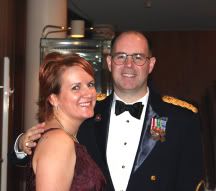So...last Saturday evening, we headed out for our first field trip. Scott Bean, our instructor gave us a list of 14 things.
If you are a photographer - don't bother to read....just look at the pictures (or, if you DO read, let me know if I'm mis-stating anything, lol!)
The first item on our list said to shoot in a manual mode (M, Av (aperture priority) or Tv (shutter speed priority))...no shots to take. The fourteenth only applied to those with a d-SLR that could do white balance adjustment.
One thing I learned...when re-setting your ISO on your Canon, and using the quick set button, be sure to actually hit SET after you've chosen the new ISO. OOPS!
All my pictures were taken in Av mode.
Some of my favorite shots were dealing with depth of field. That's basically what your eye sees. If you have a shallow depth of field, the item you're shooting will be sharp and crisp and the background will be blurry. This is great when you are up close and don't want the distraction of the stuff in the background. You accomplish this by using a small f-stop (aperture opening) and getting as close to your object and zooming in as much as you can. In the following series, you can see how I started with a high f-stop (f-36) , and I progressively lowered my f-stop until my final shot, which was f-5.6. Because I am shooting in Av, I choose the f-stop, and the camera will automatically adjust the shutter speed in order to get the optimum picture. If I were shooting in full manual, I would also have to select a good shutter speed (meaning I'd have to be metering light), but in Av mode, the camera decides one factor for you. Conversely, in Tv mode, you choose the shutter speed you'd like, and the camera will set the optimum f-stop.
f-36 (1/2 sec. shutter speed)
f-25 (1/5 sec. shutter speed)
f-20 (1/8 sec. shutter speed)
f-14 (1/15 sec. shutter speed)
f-8 (1/50 sec. shutter speed)
f5.6 (1/100 sec. shutter speed)
Notice how, in the first picture of this series, you can't really tell what my main focus was? But as I increased the aperture (smaller f-stop) you saw the seed pod come into focus, until, on the last shot, you KNEW exactly what the focus was - all the detail in the background disappears to help you see.
This is another example. On these, we just shot for high and low f-stop.

This next series of shots is my favorite. I even got a compliment from our instructor...he thought the shot was well-composed and really showed what I was trying to achieve. White Balance. The color white has a lot of different "warmths" to it. Ever wonder why some pictures look orange (if you've shot in an auditorium or concert hall - this is tungsten light)...or bluish-green (when shot under fluorescent lights? Well, that's white balance. Some whites have a blue tinge, some have a red/orange tinge. With film camera, white balance is fixed by using lens filters...but d-SLR cameras have an automatic white balance settings. Here is my series:
Automatic White Balance
Shade
Daylight
Cloudy
Tungsten
Fluorescent
Flash
Aren't those great? I love how some of the changes are subtle, and others are strong. Of course, I was shooting in daylight, so the truest photo is AWB or daylight. But I love how the picture was warmed up using the shade, cloudy and flash setting. And I truly love the tungsten and fluorescent shots...I think the white balance really can change the dynamic of a photograph!
The next shots were to "freeze motion" and "blur motion". Again, this is all about f-stop. Freezing motion is the lower f-stop...blurring motion is the higher f-stop. Generally, if you're trying to blur motion, you should have a tripod. I managed to get a decent shot by hand-holding, which is rare for me!

motion frozen...motion blurred
I really want to try this with a waterfall or rushing waters somewhere, other than the outlet tubes at Tuttle Creek resevoir...not enough water rushing out for me!
And one last shot...just because.
Friday, April 18, 2008
Photography class field trip - warning - LOTS of pictures....
written by
Linda
at
12:40 PM
![]()
Labels: photo class, photography, photophile
Subscribe to:
Post Comments (Atom)




9 comments:
now move here so we can open up a studio.
:)
Just LOVE it! You make me want a new camera.:0 Keep those pictures coming, girl!
Love your pictures. Can you share what kind of camera your using? I'm wantting a SLR camera and I have in narrowed down to Cannon or the Nikon.
Keep up the great work, your giving me lots to learn from.
Jannette D.
love, love that last shot ... gotta love the "just because" shots. lol! these are great examples of what you can really do with your settings. white balance is a big one. i admit to never changing mine ... but only because i shoot in RAW and adjust it later. lol!
I am so very jealous -- I want a class like that :(
Oh, these are wonderful and I "hear" the enthusiasm in your words as you tell us about your experiments! This is just great!
Thanks for sharing the photos!
I have no clue what all the technical terms mean and whatnot but the pictures are really nice!
Great job, Linda! One thing I learned about "white balance" is that different times of day have different "tones." Dusk typically has a bluish tone. I would love to take a really GOOD photography class. So far I've managed an adult ed class where we got to listen to how good our instructor was & look at all his great photos. Ugh. And I took a better one through a local LSS that brought in a photographer. I learned a lot more there. Enjoy & I look forward to seeing more photos! ;-)
Great photos. I have a Canon S2 IS and I've really been wanting to learn how to compose and take shots where you see depth of field like in the seedpod photos. I love the way photos look when the background is blurred.
Thanks for the lesson- now to learn how to do that with my Canon.
Post a Comment